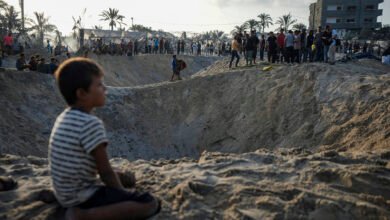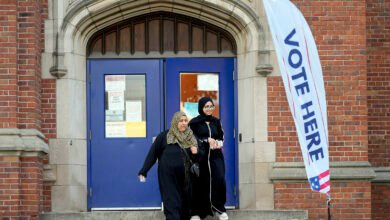
(RNS) — On one particular day of this year’s Hajj pilgrimage, Saba walked 42,000 steps in performing the rites of that day and going from one location to the other in the relentless heat with temperatures surpassing 120 degrees Fahrenheit. It was brutally hot, the kind of heat that brings on extreme sickness and even death.
While it was an incredible experience with good accommodations arranged by the group they were with, transportation was a big issue compounded by the extreme heat, said Saba, who hails from Illinois and asked that her real name not be shared for privacy reasons.
In this year’s Hajj, the convergence of extreme heat due to ongoing climate change with the packed crowds of Muslim pilgrims plus various systems that proved inadequate led to the tragic deaths from heat stroke and related illnesses of more than 1,300 Muslims.
That’s no small number. And while as Muslims we want to be accepting of whatever comes our way in Hajj — to appreciate everything God has made possible for us and to absorb the sometimes challenging lessons of gratitude, faithfulness and trust — one cannot ignore the deaths of so many people. Questions must be asked.
According to Saudi Arabia’s General Authority for Statistics, more than 1.8 million Muslims from around the world converged in Mecca and its surrounding areas for this year’s Hajj pilgrimage, which took place over five-six days in mid-June.
Saudi’s Ministry of Hajj and Umrah, as the custodians of the pilgrimage, has undertaken constant construction, expansion and improvements to accommodate pilgrims. However, every year it’s inevitable that people die during the pilgrimage for various reasons, from unavoidable ones like heart attacks and illnesses to more avoidable ones like stampedes — such as the one that occurred inside a pedestrian tunnel in 1990 killing nearly 1,500 — or fires, like the one that killed nearly 350 and injured 1,500 in 1997.
Nearly every time such a terrible tragedy occurs, improvements are made, such as increasing the number of paths and tunnels (and making them one-way) to the jamarat, the three pillars representing the devil that Muslims stone as part of their Hajj rituals. Or, banning the use of camping stoves and gas cylinders and making tents fireproof.
When we performed our Hajj in 2005, it was January, and it still felt hot to me. Because the Islamic calendar follows a lunar cycle, the date for Hajj, which falls in the first two weeks of the Islamic month of Dhul Hijjah, moves every year. The heat of the past few Hajj seasons has proven to be a terribly challenging part of the pilgrimage. The deaths this year are the worst heat-related deaths since 1985, when around 1,000 pilgrims died. That was one year before my parents went for Hajj. I was a child at the time and didn’t comprehend the seriousness of the pilgrimage they were undertaking for three weeks — neither from a faith perspective nor from a physical one.
The Saudi Ministry of Health reported that the majority of the deaths this year were of unauthorized pilgrims, including a significant number of Egyptians — 658 to be specific, 630 of whom were unregistered, as reported by Middle East Eye. Asma Yousef, a Libyan-American who lives in Washington, D.C., and hopes to go for Hajj one day, says this has to be addressed.
“I watched in real time videos of people saying that (Saudi authorities are) allowing people who showed up without a permit to go to Arafah. You could see herds of them, and they’re happy, making takbir.”
Indeed, numerous witnesses speaking with multiple news agencies reported that while security forces initially stopped (and arrested) unauthorized pilgrims from entering Mecca, they unexpectedly began allowing these pilgrims in as the Hajj was underway. But in moving between the sites of Mina, Arafah and Muzdalifah (all where certain Hajj rituals occur), unauthorized pilgrims struggled to access transportation and ended up walking several kilometers under the blazing sun, which led to serious heat strokes and deaths.
Because millions of Muslims want to perform the Hajj every year, the Saudi government issues a certain number of visas to countries around the world. Two years ago, Saudi’s Ministry of Hajj and Umrah abruptly introduced a brand-new lottery system through a Saudi-controlled website and an app. Through these, people could not only apply to go but also have access to various sites, accommodations, transportation and more.
But this year, even authorized pilgrims struggled to access transportation, said Saba. “I don’t want to complain; so much was managed beautifully. But the piece that was missing … was transportation. They really weren’t organized with the transportation piece, so we did a lot of walking and hailing cars and paying a lot of money to get us from one place to another. The fact that we could pay $250 for a car ride for a couple of miles — we were really privileged to do that.”
Yousef said multiple angles must be addressed. “This is not the first time they are managing this volume of people. By now they should have really good practices about what should be done and what should not be done.” For Yousef, it’s also important to talk about this as a tragedy.
“Part of it is cultural — if you tell someone that a loved one died in Hajj, the first thing you’ll hear is ‘Mashallah, Subhanallah, they get to be buried there. Wow, it’s such a blessing.’ As Muslims, it’s enshrined in our aqeedah (belief system) that whatever happens is written for us, and so if you raise questions, you’re questioning Allah’s will.”
But while Muslims believe that dying while performing the Hajj pilgrimage is a huge blessing, that doesn’t mitigate tragedies that could have been avoided. This isn’t right, said Yousef, adding that the management of Hajj should be questioned, even when it comes to unauthorized pilgrims.
The other piece many Muslims point to are pilgrims wanting to perform their pilgrimage in the best way possible — so their Hajj will be accepted by God. And when it’s all going well, you’re in a deep spiritual frame of mind having personal conversations with God and absorbing beautiful lessons of faith and humanity. But doing all the things exactly how you want isn’t always possible — you also need to be safe and strategic and follow the advice given by Hajj group leaders and scholars.
“If you’re offered a rukhsa (concession) by your group leader, take it,” said Saba.
When we were worshipping in Arafah during our Hajj pilgrimage, my husband and I tried to climb to the top of Jabal-e-Rahmah, where the Prophet Muhammad delivered his last sermon. Halfway up, we decided to turn back due to the overwhelming crowds coupled with the heat and fatigue I was feeling. It wasn’t a required Hajj ritual to go there and worship, so we found another place.
Often, though, things are beyond the control of those performing the Hajj, and it’s on those in charge to safeguard the process as best as possible.

Dilshad Ali. (Courtesy photo)
Many Muslims who came back from this year’s Hajj shared beautiful stories with me about the bonds of brotherhood and sisterhood, about faith-filled moments with strangers from around the world, about the immense feeling of connection with God. This is what you want to remember from the Hajj. But one can’t sweep 1,300 deaths under the rug. Climate change and intense heat waves aren’t going anywhere.
(Dilshad D. Ali is a freelance journalist. The views expressed in this commentary do not necessarily reflect those of Religion News Service.)
Source link



